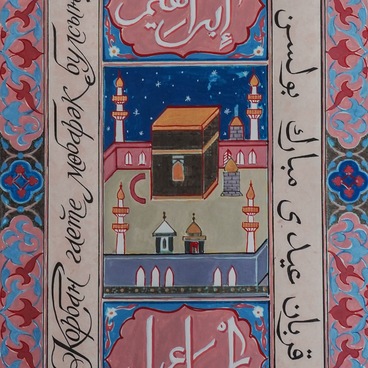Shamail Shahada is a work of Kazan Tatars’ national art. The technique used to create the painting is called shamail. The work was made using blue paints in the back of a piece of glass lined with foil. Such works have enjoyed wide popularity in the Volga-Ural region since the 19th century. They adorned the walls of mosques and private homes. Such panels traditionally featured quotes from the Holy Quran, creedal formulations and lyric stanzas written by Oriental poets.
Shamail researcher and art historian Rustem Shamsutov defines it as follows: it is a religious symbol made using Arabic calligraphy as an easel painting. Shamail has been of special importance to the culture of Tatars living in the Middle Volga region: deeply rooted in the people’s conscience, it has become one of the ways of national self-expression.
Shamail art is also found in Iran, Azerbaijan and Turkey. The painting features a calligraphically written formula ‘La ilaha illa Allah Muhammad Rasul Allah’. The phrase literally translates as ‘There is no deity except the one true God, and prophet Muhammad is the Messenger of God’. This formula is the first of the five pillars Islam is built upon.
The first part of the phrase attests to the oneness of God. The second one defines Muhammad’s messenger mission and does not imply his oneness. As Prophet Muhammad was a human being, he is not worshiped, but revered as Mustafa, the one chosen by God Almighty to deliver the Quran to people. Muslims recognize all the prophets, from Adam, Abraham (Ibrahim), Isaac (Ishaq), Ishmael (Ismail), Moses (Musa) and Jesus (Isa) to the Prophet Muhammad, and all the scriptures revealed prior to the Quran.
The shamail is entitled Shahada, which literally translates from Arabic as “the symbol of faith”. The author of the painting is Nazip Ismagilov (alias Nadjip Naqqash), a recognized artist, winner of the Gabdulla Tukai State Prize of the Republic of Tatarstan. The museum hosted two solo shows by the great artist.
Nazip Fayzrakhmanovich is credited with the revival of an ancient Tatar fine art from – Arabic calligraphy – which has become almost extinct in modern Tatarstan in the past 80 years. He participates in many national, interregional and international exhibitions (in Iran, Turkey, France), his works have been purchased by many museums in Kazan, Naberezhnye Chelny, Almetyevsk and private collectors.
Shamail researcher and art historian Rustem Shamsutov defines it as follows: it is a religious symbol made using Arabic calligraphy as an easel painting. Shamail has been of special importance to the culture of Tatars living in the Middle Volga region: deeply rooted in the people’s conscience, it has become one of the ways of national self-expression.
Shamail art is also found in Iran, Azerbaijan and Turkey. The painting features a calligraphically written formula ‘La ilaha illa Allah Muhammad Rasul Allah’. The phrase literally translates as ‘There is no deity except the one true God, and prophet Muhammad is the Messenger of God’. This formula is the first of the five pillars Islam is built upon.
The first part of the phrase attests to the oneness of God. The second one defines Muhammad’s messenger mission and does not imply his oneness. As Prophet Muhammad was a human being, he is not worshiped, but revered as Mustafa, the one chosen by God Almighty to deliver the Quran to people. Muslims recognize all the prophets, from Adam, Abraham (Ibrahim), Isaac (Ishaq), Ishmael (Ismail), Moses (Musa) and Jesus (Isa) to the Prophet Muhammad, and all the scriptures revealed prior to the Quran.
The shamail is entitled Shahada, which literally translates from Arabic as “the symbol of faith”. The author of the painting is Nazip Ismagilov (alias Nadjip Naqqash), a recognized artist, winner of the Gabdulla Tukai State Prize of the Republic of Tatarstan. The museum hosted two solo shows by the great artist.
Nazip Fayzrakhmanovich is credited with the revival of an ancient Tatar fine art from – Arabic calligraphy – which has become almost extinct in modern Tatarstan in the past 80 years. He participates in many national, interregional and international exhibitions (in Iran, Turkey, France), his works have been purchased by many museums in Kazan, Naberezhnye Chelny, Almetyevsk and private collectors.

